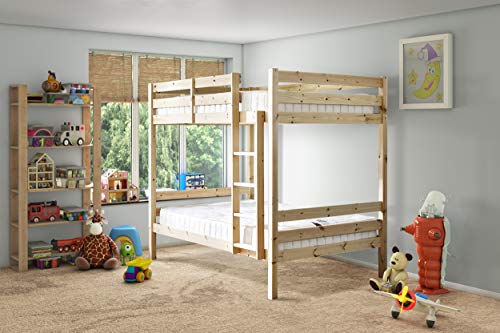How to Shop Bunk Bed Furniture
Bunk beds are a great option to free up space in the children's bedroom. There are a variety of designs that are available, ranging from desks attached to staircase bunks.
It can be difficult to select the perfect bunk bed for your child. It's essential to pick the bunk bed both of you each like. It's also crucial to select the right style, construction and size.
How to Select the Best Bunk Bed
There are numerous kinds of bunk beds to choose from but it's important to select the right one for your child. When choosing the best bunk beds for your child, you need to take into account the height of the bed and the size of the room.
The bunk bed you choose is one that is comfortable for your child. It should be safe and provide plenty of storage space. It should also include a mattress that will be suitable to your child's size and requirements.
It can be a challenge to choose the best bunk beds , however, you must think about the way your child will be using them and what features they would like. You might want to think about adding a trundle for extra sleep space or drawers for storage.
Take into consideration the material the frame for your bunk bed is composed of. A majority of bunk bed frames are made from wood, but some are constructed from metal too. This is an excellent option for your child's bedroom however, it isn't as sturdy.
Bunk beds can be decorated to match the individuality of your child. Your child will feel more at ease and have a chance express themselves when they have their own space.
A bunk bed is a cost-effective and practical solution for your family, regardless of whether you're building your own home or renovating one that already exists. It can be used in a guest room or a child's room, or a cabin for vacation or.
Stairs and Ladders
Bunk beds can be found in a variety of types, shapes and sizes. It is important to select the bunk bed that best suits your lifestyle and decorative style and your child's needs.
For example, you may think about a twin over twin bed or a full over full bunk bed that has stairs that double as storage space. These models are more stylish and can free up a lots of space.
Stairs are more likely be safer than ladders, particularly for children younger than. They have wider steps, and a solid rail that is surrounded by your child while they climb. Some have grooves that help prevent slipping.
A bunk bed with steps is a practical, safe and comfortable choice for your children. It can also be used in a variety of styles and helps to conserve space.
If you choose a bunk bed with a ladder, be sure the ladder's rungs aren't too narrow. It is also possible to put an extra cushion on the ladder to make it more comfortable.
Ladders are a lot easier for younger children to climb up, but they can be more difficult for older children. They're also more expensive than stairs, so it's important to decide whether you're willing to invest the money to buy a ladder.
After the bunk bed is built and erected, teach your child to use it safely. This includes using both hands and facing the ladder or stairs when climbing. It's also important to supervise your child as they use the bunk bed.
Age of the Child
When selecting a bunk bed, the age of your child must be taken into consideration. When choosing whether or not you should buy a bunk bed, you should consider your child's safety and happiness as well as their sleeping habits.
It is generally recommended that children be at minimum six years old before they can sleep in a top bunk. This is because children are more likely to able climb up and down a ladder or stay safely on the bed at night.
It is also important to consider the maturity level of your child as well as their comfort level with heights. If your child is afraid of heights, you might think about bunk beds with an lower bunk.
You must also consider the floor space in your bedroom. Make sure the top and bottom bunks match the ceiling. You should leave a minimum of 30 inches (2.5 feet) or at the very least 2.5 feet, between the ceiling and beds so that your child isn't able to hit their head on the top bunk or roof while they are sitting up.
Also, you should look for bunk beds that have additional safety features. Most bunk beds come with guard rails that protect children from falling off the top bunk, or becoming trapped in the bottom bunk.
Floor Space
Bunk beds are an excellent option to make room regardless of whether you have one or two. They make room to accommodate other furniture, like a desk, or play area, and provide children more space to move around their bedroom.
Bunk beds can be built up to three inches high, and they can be found in many configurations to suit your needs. Some styles are designed to accommodate guests, while others have a built-in desk with storage underneath.
If you need to reduce area, try to find a bunk bed that can be positioned horizontally rather than vertically. This might not be feasible in all situations, however it is a good start.
When deciding on the right bunk beds, it is crucial to take into consideration your ceiling heights. The standard ceiling height is between 8 9 and 8. There are loft beds and bunk beds with lower heights that will work in smaller spaces.
To get the most benefit of a bunk bed you must consider the best features and how it will fit into your bedroom design. For instance, you'll want to make sure that the top bunk has a ladder or guard rails as well as the bottom bunk has under-bed drawers. You'll have to think about how your child will use the beds. For instance, will they sleep in the top bunk for the majority of the time or do they require an office with storage underneath the bottom bed?

Style
Bunk beds are available in a variety of different styles and can be made to fit your child's bedroom. They are also an excellent option to make space for the floor space in your child's space, particularly if have a limited space.
There are many types of bunk beds, from standard or basic models to lofts with a desk. You can also find bunks with built-in bookcases or drawers if you're looking for more storage.
The most comfortable bunk beds are constructed with high-quality wood along with a sturdy frame and comfortable mattresses. Mattresses that are between 5 and 6 inches thick work well for bunk beds. This allows the rails of the guard to be uncovered above the top of the mattress, maximizing security.
When purchasing bunk beds be sure to look for safety features like an extended or short guard rail frames that attach to the upper bed. This will stop your child from accidentally rolling out of bed while sleeping.
childrens bunk beds include a short ladder attached to the top and lower rails. This type of ladder helps your child gain access to the bed's drawers and trundles, without getting obstructions.
You can also select from a variety of mattresses to ensure your child has the comfort and support they need. There are numerous options on the market. You can choose from hybrid foam to latex. You can also find bunk beds that come with a slide so that your child can have fun when they wake up in the morning.
Safety
A bunk bed can be an enjoyable and thrilling option for bedrooms of all kinds However, it's essential to think about safety when you purchase one. The safety features on bunk beds, such as guard rails and ladders, are designed to protect you from injuries or accidents resulting from falling or entrapment or structural failure.
A guardrail should be installed on all four sides of the top bunk. This prevents children from falling off the top bunk and injuring themselves.
The space between the guardrails and the sides of the bed should be no more than 3 1/2 inches in width. This ensures that there's no room for your child to roll underneath the bed when they're sleeping.
Also, make sure that the guardrails are 16cm higher than the mattress to stop your child from rolling out of bed. The mattresses on the lower and upper bunks should also be placed snugly across the four sides of bed and should not be any deeper than 15cm.
If you're looking to purchase bunk beds, make sure that they meet the stringent standards of your country's safety department. These rules cover every aspect of bunk beds, including their design and construction. They also pay attention to the gaps and spaces that can easily trap tiny arms, legs and heads.
